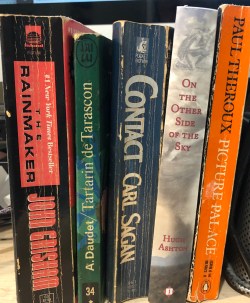Our local writers’ group gave as an exercise a re-placement of a fairy-tale character in a novel situation. However, I decided to be a little different (surprise, surprise) and ended up writing a slightly surreal piece of nonsense loosely based on what I could remember of Jack and the Beanstalk.
Once upon a time, there was a boy named Jack who lived with his mother in a small cottage hallway between the towns of Nowhere and Nothing. They were so poor that they used to beg for crumbs from the church mice who sometimes came to visit, but their sole possession, other than a 42” plasma TV, was a cow called Eric. The television had never worked, chiefly because there was no electricity in the cottage, but it was very useful for stopping the draft from the broken window.
“Why is our cow called Eric, Mother?” Jack would ask on long winter evenings. Sometimes he asked the same question on short summer evenings, but not so often, because the evenings were shorter.
He always forgot the answer that his mother gave him, and his mother always forgot that he had asked the same question twenty times already that month. So they were both perfectly happy with that evening’s entertainment.
“Who needs Netflix,” they would ask each other, “when you have a cow called Eric?”
But neither of them knew the answer to that question.
There came a time when even the church mice stopped coming, pleading pressure of work, and a disturbing trend in atheism.
“We must sell Eric,” said Jack’s mother. “You must go to the market in Nowhere and sell her, so that we can eat.”
So, one day, Jack set off for the market of Nowhere, leading Eric on a piece of string. His mother waved farewell to them with her last clean paper tissue, which she had been saving for Sunday best, but she had brought it out in honour of the occasion.
In six hours, Eric returned, leading Jack on the same piece of string.
Jack’s mother was about to ask Eric what had happened, when she stopped, realising that she had forgotten to put her false teeth in, and that Eric wouldn’t be able to understand her. She turned to Jack.
“I’m sorry, mother,” said Jack. “I tried to sell Eric so that we could feed ourselves, but no one wanted to give me anything to eat. All they wanted to give me in exchange was money. And you can’t eat it. I tried, and it tasted horrible.”
“Oh, you silly boy! Trying to eat money like that!” said his mother impatiently. “Surely you know that you can’t eat it raw. It has to be cooked. Tomorrow you must go to the market at Nothing, and sell Eric there.”
So, the next day, Eric and Jack set off for Nothing.
Jack’s mother was surprised to see Jack return alone a couple of hours later, holding a piece of string.
“Where’s Eric?” she asked.
“Sold her,” Jack said, with an air of pride.
“How?” said his mother. “I remembered just after you’d gone that it was Sunday, and there wouldn’t be a market. Still, I said to myself, the exercise will do you both good. It’s only five miles each way. So… how much did you get for Eric?”
Jack opened his hand to display five beans. “The man who bought Eric told me that these were really good if you cooked them in tomato sauce and put them on buttered toast.”
Jack’s mother sighed. “I don’t know how you can be so stupid. There are five beans there, and two of us. How are we going to manage to divide them fairly?” And she angrily snatched the beans out of Jack’s hand, and threw them out of the window (the one which wasn’t blocked by the 42” plasma TV), where they were snatched up by a passing squirrel and eaten.
Overnight, the beans sprouted and grew and grew. Which wasn’t so nice for the squirrel. But that’s another story. And not one for bedtime.
Eric grew to a ripe old age, and took second prize at the Miss Nowhere beauty contest two years after she had been sold for five beans.
Jack’s mother reluctantly dug up the box of £20 notes that she had been saving for a rainy day, although the forecast only said scattered showers, and went to Tesco, where she bought a Warburton’s sliced loaf, a pack of Lurpak spreadable butter which was almost past its expiry date, and three tins of baked beans on special offer. Jack and his mother lived, but not very happily, and not ever after.
I worry about me sometimes.






























